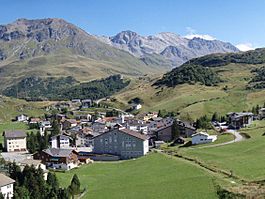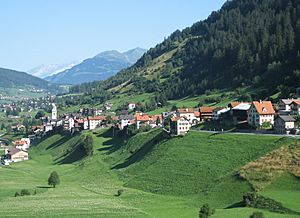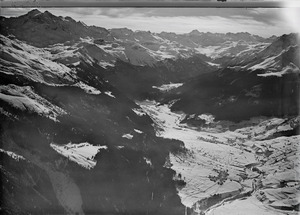Surses facts for kids
Quick facts for kids
Sursés
|
||
|---|---|---|

Bivio village
|
||
|
||
| Country | Switzerland | |
| Canton | Grisons | |
| District | Albula | |
| Area | ||
| • Total | 323.77 km2 (125.01 sq mi) | |
| Population
(Dec 2020 )
|
||
| • Total | 2,377 | |
| • Density | 7.3416/km2 (19.015/sq mi) | |
| Postal code |
7452-57; 7460-3
|
|
| Localities | Savognin, Bivio, Tinizong, Cunter, Rona, Salouf, Riom, Parsonz, Mulegns, Sur, Radons, Marmorera, Munter, Faller, Panaglia, Tigignas | |
| Surrounded by | Avers, Bever, Sils im Engadin/Segl, Silvaplana, Soglio, Stampa, | |
Sursés (also known as Oberhalbstein in German) is a cool place in the Albula Region of Switzerland. It's part of the Graubünden area. On January 1, 2016, several smaller towns joined together to create the Sursés you see today. These towns were Bivio, Cunter, Marmorera, Mulegns, Riom-Parsonz, Salouf, Savognin, Sur, and Tinizong-Rona.
Contents
A Look Back in Time: Sursés History
Bivio's Story
The village of Bivio was first mentioned around the year 840. Back then, it was called de stabulo Bivio. For a while, it was known as Stallen in German.
Cunter's Beginnings
Cunter is another old village. People first wrote about it in 1370, calling it Contra.
Marmorera's Past
Marmorera was first mentioned around 840 as ad Marmoraria. The original village was actually flooded! This happened when the Marmorera dam was built. The current village was then built higher up, above the Lai da Marmorera lake.
Mulegns' History
Near Mulegns, people found an old copper mine and a metal smelter. These were built way back around 600-500 BC! The village itself was started by a group of people called Walsers in the 1400s. It was first mentioned in records in 1521.
Riom-Parsonz: Two Towns Become One
Riom-Parsonz was formed in 1979. This is when the towns of Parsonz and Riom decided to join together. Riom was first mentioned in 841 as villa Riamio. Parsonz was mentioned later, in 1156, as Presan.
Riom was a busy place during the Roman era, from the 1st to the 4th century. It was a mansio, which means a kind of rest stop along the Julier Pass road. Even after the Roman Empire ended, farmers and herders kept living there. In 840, it was owned by the king of Raetia Curiensis and was an important local center.
Salouf's Early Days
Salouf was first mentioned in 1160 as Salugo.
Savognin Through the Ages
Savognin was first mentioned in 1154 as Sueningin.
There was an important settlement from the Bronze Age on Padnal hill, south of Savognin. Many cool things have been found there from around 1800 to 1000 BC.
Since Roman times, important travel routes have gone through the Julier and Septimer passes. Savognin became part of the Bishops of Chur's land in the 1200s. It was a main town in the Oberhalbstein area. Later, in 1552, the valley became fully independent.
For a long time, the economy of Savognin was based on raising cattle and the travelers passing through. When the Gotthardbahn railway opened in 1882, it changed things. Fewer people traveled through the passes, and Savognin became more of a farming village.
However, in the 1960s, tourism started to grow. Hotels, vacation homes, and cable cars (like the one to Piz Martegnas) were built. This helped Savognin become a popular place for visitors.
Sur's Past
Near Sur, you can find Spliatsch Castle. It was built around the early 1200s by the Marmels family. In 1663, Capuchin friars built the beautiful Baroque church of S. Catregna. It was built on the old foundations of a medieval church. Today, this church is part of a parish with Mulegns and Marmorera. Before the Rhaetian Railway was built, Sur was a group of farmhouses. Many people there worked as guides for travelers.
Tinizong-Rona: A Roman Stop
Tinizong was mentioned during the Nervan–Antonine dynasty (96 to 192 AD) of the Roman Empire. It was called Tinetione and was a stop on the Roman Septimer Pass route. Rona was first mentioned in 1330 as Rouenam.
Where is Sursés?
Sursés covers an area of about 76.73 square kilometers. The beautiful lake Lai Lung is located within its borders.
Sursés Population
Sursés has a population of about 2,425 people (as of December 2014).
Weather in Sursés
The Bivio weather station gets about 132.1 days of rain each year. On average, it receives 1198 mm (47.2 in) of precipitation. The wettest month is August, with about 138 mm (5.4 in) of rain over 11.9 days. May has the most rainy days (13.1 days), but with less rain (125 mm or 4.9 in). February is the driest month, with only 56 mm (2.2 in) of rain over 11.9 days.
The Savognin weather station gets about 104.3 days of rain per year. It receives about 917 mm (36.1 in) of precipitation on average. August is the wettest month, with 117 mm (4.6 in) of rain over 11.8 days. February is the driest, with about 42 mm (1.7 in) of rain over 11.8 days.
Important Historic Sites
Sursés has several important historical sites. These include a Roman mountain shrine near Bivio, Riom Castle in Riom-Parsonz, and the Chasa Fontana No. 26 in Salouf. In Savognin, you can find the Son Martegn Church and the Padnal/Mot la Cresta, which is a Bronze Age settlement. The Church of S. Plasch (St. Blasius) and the Chasa Cresta Nr. 5 in Tinizong-Rona are also very important. These places are listed as Swiss heritage sites of national significance.
The Church of Son Martegn was built in 1677. It has a huge painting (fresco) from 1681 by Carlo Nuvolone from Milan.
The Church of S. Plasch was first mentioned in 1180. It was rebuilt in 1663 by Capuchin friars from its original Gothic style.
Famous People from Sursés
- The Italian painter Giovanni Segantini lived in Savognin from 1886 to 1894. He created many of his famous landscape paintings there, often showing Mounts Piz Curver and Piz Tiossa.
- The poet and priest Alexander Lozza, who wrote in the Romansh language, was born here in 1880.
- The Swiss religious leader Mauro Jöhri was born here in 1947.
Fun Fact
The 2007 Swiss mystery movie Marmorera was filmed in Marmorera and at the dam's reservoir.







